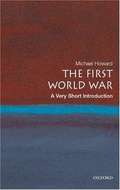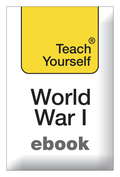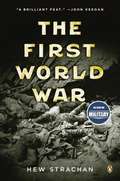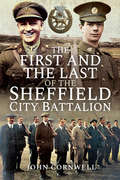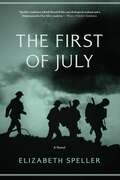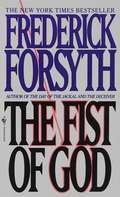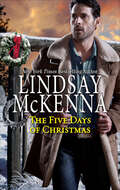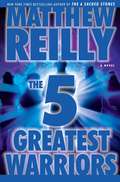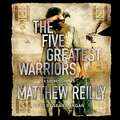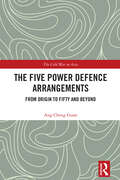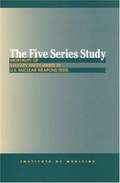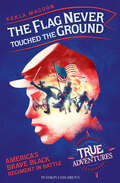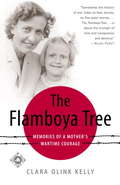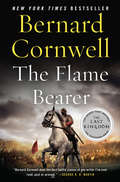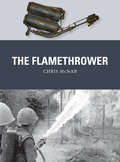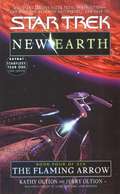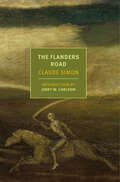- Table View
- List View
The First World War: A Miscellany
by Norman FergusonTelling the stories of the battles, the aircraft, the weapons, the soldiers, the poets, the campaigns and the many heroes, this comprehensive miscellany is a compelling guide to a war that transformed and marked forever the course of twentieth-century history.
The First World War: A Very Short Introduction
by Michael HowardBy the time the First World War ended in 1918, eight million people had died in what had been perhaps the most apocalyptic episode the world had known. This Very Short Introduction provides a concise and insightful history of the 'Great War', focusing on why it happened, how it was fought, and why it had the consequences it did. It examines the state of Europe in 1914 and the outbreak of war; the onset of attrition and crisis; the role of the US; the collapse of Russia; and the weakening and eventual surrender of the Central Powers. Looking at the historical controversies surrounding the causes and conduct of war, Michael Howard also describes how peace was ultimately made, and the potent legacy of resentment left to Germany.
The First World War: Teach Yourself
by David EvansThe Teach Yourself History series offers an alternative to academic historical books, its content being extensive yet extremely accessible and the approach refreshingly different. The books are informative and compelling, and engage the reader from beginning to end. They assume no prior historical knowledge, and are full of anecdotes and details that provide a very personal appeal. Teach Yourself The First World War covers all aspects of the war from an international perspective. It follows its key developments, including the build up to the war, how it developed and the role of the different countries involved. It considers many intriguing aspects of the war, including life in the trenches, spies and espionage, the role of women, propaganda, weapons of war and the loss of life. It looks at the impact of the war on those involved and questions why Germany lost the war. The aim throughout is to give you a better understanding of the events that ultimately led to the slaughter of some nine million men and left a further twenty-nine million either wounded or missing.
The First World War: The War To End All Wars (Essential Histories Specials Ser. #No.2)
by Hew Strachan"This serious, compact survey of the war's history stands out as the most well-informed, accessible work available." (Los Angeles Times) Nearly a century has passed since the outbreak of World War I, yet as military historian Hew Strachan argues in this brilliant and authoritative new book, the legacy of the "war to end all wars" is with us still. The First World War was a truly global conflict from the start, with many of the most decisive battles fought in or directly affecting the Balkans, Africa, and the Ottoman Empire. Even more than World War II, the First World War continues to shape the politics and international relations of our world, especially in hot spots like the Middle East and the Balkans. Strachan has done a masterful job of reexamining the causes, the major campaigns, and the consequences of the First World War, compressing a lifetime of knowledge into a single definitive volume tailored for the general reader. Written in crisp, compelling prose and enlivened with extraordinarily vivid photographs and detailed maps, The First World War re-creates this world-altering conflict both on and off the battlefield--the clash of ideologies between the colonial powers at the center of the war, the social and economic unrest that swept Europe both before and after, the military strategies employed with stunning success and tragic failure in the various theaters of war, the terms of peace and why it didn't last. Drawing on material culled from many countries, Strachan offers a fresh, clear-sighted perspective on how the war not only redrew the map of the world but also set in motion the most dangerous conflicts of today. Deeply learned, powerfully written, and soon to be released with a new introduction that commemorates the hundredth anniversary of the outbreak of the war, The First World War remains a landmark of contemporary history.
The First and the Last of the Sheffield City Battalion
by John CornwellThis is the story of two British men from very different social backgrounds, who both joined a new Pals battalion during World War I.To encourage men to volunteer, the British Army established Pals battalions that allowed men who enlisted together to serve together during the First World War. One of these men was Vivian Simpson, a 31-year-old solicitor who was well known in the city; partly because he was an outstanding footballer, playing for Sheffield Wednesday and an England trialist. Simpson was the very first man to enroll for the new battalion and was commissioned in January 1915.The other man was Reg Glenn, a clerk in the Education Offices who served as a signaler in each battle the 12th Battalion fought in until the summer of 1917, when he was selected to become an officer.To his annoyance, Vivian Simpson was kept back in England as a training officer until after the battalion’s disaster on the Somme on 1 July 1916. However, after that he became a most energetic and courageous officer. He was awarded an MC in 1917, but was killed in the German offensive on the Lys in April 1918.Reg Glenn went back to France in 1918 as a subaltern in the North Staffordshires and was wounded on the Aisne in his first day of combat as an officer. He was never fit enough to go back to the trenches and became a training officer in Northumberland with his new regiment and later with the Cameronians at Invergordon. He survived the war and lived to be 101 years old, making him the last survivor of the 12th Battalion.
The First of July
by Elizabeth SpellerOn July 1st, 1913, four very different men are leading four very different lives. Exactly three years later, it is just after seven in the morning, and there are a few seconds of peace as the guns on the Somme fall silent and larks soar across the battlefield, singing as they fly over the trenches. What follows is a day of catastrophe in which Allied casualties number almost one hundred thousand. A horror that would have been unimaginable in pre-war Europe and England becomes a day of reckoning, where their lives will change forever, for Frank, Benedict, Jean-Batiste, and Harry. Elizabeth Speller once again sublimely captures the dangerously romantic atmosphere of war-torn Europe in her latest novel that will leave critics and readers astounded.
The First to Land
by Douglas ReemanCaptain David Blackwood is embroiled in the Boxer Rebellion. Ordered to escort a beautiful German countess on a dangerous journey up the Hoshun River, Blackwood sees death and slaughter unlike anything he has known. Finally, standing before the walls of Tientsin, he must hold on against a torrent of frenzied Chinese warriors.
The Five Days of Christmas: State Secrets; The Five Days Of Christmas (Morgan's Mercenaries #18)
by Lindsay McKennaA military veteran and a widow find a second chance at love in this emotional holiday romance from a New York Times–bestselling author.Colt Hamlin doesn’t expect much under his tree this Christmas. After all, the world-weary mercenary is just looking to get his life back on track. But when his boss’s wife decides to work a little matchmaking magic, Colt finds himself face to face with Montana’s prettiest widow, Abbie Clemens. And their chemistry is nothing short of electric . . . Praise for Lindsay McKenna:“McKenna skillfully takes readers on an emotional journey into two people’s hearts.” —Publishers Weekly
The Five Fingers
by Gayle Rivers James HudsonA 7 man multinational special operations team is sent to a village in China near the Vietnam border to assassinate General Giap, and the high ranking Chinese officials he is meeting with. 340 pages
The Five Greatest Warriors: A Novel (Jack West, Jr. #3)
by Matthew ReillyThe New York Times bestselling sequel to the bestsellers The Six Sacred Stones and Seven Deadly Wonders.It began with six stones...From the deserts of Israel to the tsunami-lashed coasts of Japan, from the steppes of Mongolia to the most mysterious island on Earth—this is what we have come to expect from Matthew Reilly: stupendous action, white-knuckle suspense, heroes to cheer for, and an adventure beyond imagination. Strap yourself in and hold on tight as he unleashes his biggest and fastest adventure yet, The 5 Greatest Warriors. When we last left Jack West Jr., he was plummeting into a fathomless abyss and his quest to save the world from impending Armageddon appeared doomed. But all hope is not lost. After an astonishing escape, Jack regroups with his trusty team. Racing to rebuild the final pieces of the fabled &“Machine,&” they discover an ancient inscription containing a rhyme about five mysterious unnamed warriors—great historical figures whose knowledge will be vital to unlocking the secrets of the Machine and its long-lost &“pillars.&” But the ancients have hidden their secrets well, and with each pillar bestowing an incredible power upon its holder, their pursuit has attracted the attention of other forces from around the world—some who want to rule it and others who want to see it destroyed. With enemies coming at him from every side and the countdown to doomsday rapidly approaching, Jack and his team had better move fast. Because they are about to find out what the end of the world looks like...
The Five Greatest Warriors: The battle to save the world has begun... (Jack West Series)
by Matthew ReillyThe end is approaching ... Can Jack West unravel the ancient secrets of the Five Greatest Warriors and save the world?With the end of the world fast approaching, Jack West Jnr must rebuild the final pieces of the fabled, ancient 'Machine' - the only thing that can prevent global catastrophe. But he is out of clues, out of leads ... until he is presented with an ancient text about five unnamed warriors, great historical figures who were all in some way connected to the mysterious Machine. And so Jack and his loyal team set out to discover their identities - and their secrets.Soon Jack is on the trail of a legendary list of greats: from Moses to Genghis Khan and Napoleon, and finally to one most unlikely warrior, the unknown 'Fifth', who, it is said, will be there 'at the end of all things...'Read by Sean Mangan(p) 2009 Bolinda Publishing Pty Ltd
The Five Power Defence Arrangements: From Origin to Fifty and Beyond (The Cold War in Asia)
by Ang Cheng GuanAng describes the development of the Five Power Defence Arrangements (FPDA), an important security regional arrangement, from its inception to the present from the perspectives of the five FPDA allies.The book recounts the establishment of the FPDA in 1971 from the Anglo-Malaysian Defence Agreement and its development in the first 20 years to the end of the Cold War in 1990. Based on declassified archival documents and secondary literature, it explores how the FDPA has evolved and adapted to provide different benefits to each of its partners after the Cold War. Ang contextualises the FPDA within existing scholarship and offers a glimpse into possible future trajectories.A valuable resource for scholars, students, researchers, and professionals interested in international history, defence, and security.
The Five Series Study: MORTALITY OF MILITARY PARTICIPANTS IN U.S. NUCLEAR WEAPONS TESTS
by Institute of MedicineInformation on the Mortality of Military Participants in US Nuclear Weapons Tests
The Flag Never Touched the Ground: America’s Brave Black Regiment in Battle (True Adventures)
by Kekla MagoonThe story of an all-black regiment's assault on the impregnable Fort Wagner in the Civil War, an act of extraordinary courage that changed hearts and minds in America for everTHE AMERICAN CIVIL WAR. 1863. On a cold beach in South Carolina, the soldiers of the 54th Massachusetts Regiment are marching into battle. Their mission: to capture the impregnable Fort Wagner. The odds are heavily against them, and the stakes could not be higher - they are one of the first all-Black regiments in the Union Army, and all of America is watching them. Among their ranks is William Harvey Carney. A former enslaved man who escaped to the North, he knows what a precious thing freedom is. So when the bugle sounds, and the regimental flag is hoisted high, William charges towards the guns.
The Flamboya Tree
by Clara Kelly"The Flamboya Tree is a fascinating story that will leave the reader informed about a missing piece of the World War II experience, and in awe of one family's survival."--Elizabeth M. Norman, author of We Band of Angels: The Untold Story of American Nurses Trapped on Bataan by the Japanese "It is a well-known fact that war, any war, is senseless and degrading. When innocent people are brought into that war because they happen to be in the wrong place at the wrong time, it becomes incomprehensible. Java, 1942, was such a place and time, and we were those innocent people."Fifty years after the end of World War II, Clara Olink Kelly sat down to write a memoir that is both a fierce and enduring testament to a mother's courage and a poignant record of an often overlooked chapter of the war.As the fighting in the Pacific spread, four-year-old Clara Olink and her family found their tranquil, pampered lives on the beautiful island of Java torn apart by the invasion of Japanese troops. Clara's father was taken away, forced to work on the Burma railroad. For Clara, her mother, and her two brothers, the younger one only six weeks old, an insistent knock on the door ended all hope of escaping internment in a concentration camp. For nearly four years, they endured starvation, filth-ridden living conditions, sickness, and the danger of violence from their prison guards. Clara credits her mother with their survival: Even in the most perilous of situations, Clara's mother never compromised her beliefs, never admitted defeat, and never lost her courage. Her resilience sustained her three children through their frightening years in the camp.Told through the eyes of a young Clara, who was eight at the end of her family's ordeal, The Flamboya Tree portrays her mother's tenacity, the power of hope and humor, and the buoyancy of a child's spirit. A painting of a flamboya tree--a treasured possession of the family's former life--miraculously survived the surprise searches by the often brutal Japanese soldiers and every last-minute flight. Just as her mother carried this painting through the years of imprisonment and the life that followed, so Clara carries her mother's unvanquished spirit through all of her experiences and into the reader's heart.From the Hardcover edition.
The Flame Bearer (Saxon Tales #10)
by Bernard CornwellThe tenth installment of Bernard Cornwell’s New York Times bestselling series chronicling the epic saga of the making of England, “like Game of Thrones, but real” (The Observer, London)—the basis for The Last Kingdom, the hit television series.Britain is in a state of uneasy peace. Northumbria’s Viking ruler, Sigtryggr, and Mercia’s Saxon Queen Aethelflaed have agreed a truce. And so England’s greatest warrior, Uhtred of Bebbanburg, at last has the chance to take back the home his traitorous uncle stole from him so many years ago—and which his scheming cousin still occupies.But fate is inexorable, and the enemies Uhtred has made and the oaths he has sworn conspire to distract him from his dream of recapturing his home. New enemies enter into the fight for England’s kingdoms: the redoubtable Constantin of Scotland seizes an opportunity for conquest and leads his armies south. Britain’s precarious peace threatens to turn into a war of annihilation. Yet Uhtred is determined that nothing—neither the new adversaries nor the old foes who combine against him—will keep him from his birthright. “Historical novels stand or fall on detail, and Mr. Cornwell writes as if he has been to ninth-century Wessex and back.”—Wall Street Journal
The Flames of War: The Fight for Upper Canada, July—December 1813
by Richard FeltoeThe third in a series of unique surveys of the battles in the War of 1812. In April 1813 the Americans launched a new campaign to conquer Upper Canada, after their failure to do so in 1812. However, following initial victories, the U.S. assault stalled as a combined force of British regulars, Canadian militia, and Native allies counterattacked, throwing the Americans entirely onto the defensive by the end of June. During the next six months, this seesaw of military advantage was repeated again and again as each side escalated its commitment of men and resources and fought to gain the "final" victory. Unfortunately, this also brought with it an increasing level of destruction and hardship suffered by armies and civilian populations on both sides of the border. Numerous images of locations at the time are counterpointed with modern pictures taken from the same perspective to give a true then-and-now effect. Maps are also included to trace the course of individual battles stage by stage, while placing and moving the shifting formations of troops across a geographically accurate battlefield. This third volume in the six-part series Upper Canada Preserved — War of 1812 recounts the dramatic and destructive campaigns in the last six months of 1813 as the Americans continued their remounted attack on Upper Canada.
The Flamethrower
by Chris Mcnab Steve NoonFire is one of humanity's most rudimentary tools, but also one of its oldest killers. This focus of this book is a weapon that has literally placed the power of fire in human hands - the man-portable flamethrower. From its very first use in World War I to its deployment in Vietnam, the weapon has proven to be devastatingly effective, not least because of its huge psychological impact on enemy troops - few other weapons in history have caused such terror. Yet despite this, the man-portable flamethrower has always been vulnerable, suffering from a very particular set of limitations, all of which are explored here, as are some lesser-known capabilities such as the ability to 'bounce' a stream of flammable liquid off the interior surfaces of fortified structures. Featuring expert analysis, first-hand accounts, and a startling array of illustrations and photographs, this book is the definitive guide to an extraordinary chapter in the history of military technology.
The Flaming Arrow: New Earth #4 (Star Trek: Vanguard #92)
by Jerry Oltion Kathy OltionBeyond the borders of the Federation, Kirk must bring peace and security to the final frontier. His new mission: to defend an isolated human colony an a newly discovered world, deter aggression from neighboring alien races, and ensure the survival of a brave new Earth! The Flaming Arrow Belle Terre's stubborn colonists have survived the countless hardships and natural disasters of their new home, only to face a deadly foreign enemy. The alien Kauld, intent on claiming the world's unique resources for their own are determined to destroy the human settlements at any cost. Months away from any hope of Starfleet reinforcements, the Starship Enterprise is all that stands between Belle Terre and an all-out alien invasion. But Kirk and his valiant crew may not be enough to save the planet from a relentless assault by the ultimate superweapon!
The Flanders Road
by Claude SimonBy the winner of the 1985 Nobel Prize in Literature, a riveting, stylistically audacious modernist epic about the French cavalry's bloody face-off against German Panzer tanks during WWII.On a sunny day in May 1940, the French army sent out the cavalry against the invading German army&’s panzer tanks. Unsurprisingly, the French were routed. Twenty-six-year-old Claude Simon was among the French forces. As they retreated, he saw his captain shot off his horse by a German sniper.This is the primal scene to which Simon returns repeatedly in his fiction and nowhere so powerfully as in his most famous novel The Flanders Road. Here Simon&’s own memories overlap with those of his central character, Georges, whose captain, a distant relative, dies a similar death. Georges reviews the circumstances and sense—or senselessness—of that death, first in the company of a fellow prisoner in a POW camp and then some years later in the course of an ever more erotically charged visit to the captain&’s widow, Corinne. As he does, other stories emerge: Corinne&’s prewar affair with the jockey Iglésia, who would become the captain&’s orderly; the possible suicide of an eighteenth-century ancestor, whose grim portrait loomed large in Georges&’s childhood home; Georges&’s learned father, whose books are no help against barbarism. The great question throughout, the question that must be urgently asked even as it remains unanswerable, is whether fiction can confront and respond to the trauma of history.
The Flatpack Bombers: The Royal Navy and the Zeppelin Menace
by Ian GardinerOur vision of aviation in the First World War is dominated by images of gallant fighter pilots duelling with each other high over the Western Front. But it was the threat of the Zeppelin which spurred the British government into creating the Royal Flying Corps, and it was this menace, which no aircraft could match in the air at the beginning of the war, which led Winston Churchill and the Royal Navy to set about bombing these airships on the ground. Thus in 1914, the Royal Naval Air Service, with their IKEA-style flatpack airplanes, pioneered strategic bombing. Moreover, through its efforts to extend its striking range in order to destroy Zeppelins in their home bases, the Royal Navy developed the first true aircraft carriers.This book is the story of those largely forgotten very early bombing raids. It explains the military and historical background to the first British interest in military and naval aviation, and why it was that the Navy pursued long distance bombing, while the Army concentrated on reconnaissance. Every bomber raid, and every aircraft carrier strike operation since, owes its genesis to those early naval flyers, and there are ghosts from 1914 which haunt us still today.
The Flechas: Insurgent Hunting in Eastern Angola, 1965–1974 (Africa@War #11)
by John Cann<p>In 1961, Portugal found itself fighting a war to retain its colonial possessions and preserve the remnants of its empire. It was almost completely unprepared to do so, and this was particularly evident in its ability to project power and to control the vast colonial spaces in Africa. Following the uprisings of March of 1961 in the north of Angola, Portugal poured troops into the colony as fast as its creaking logistic system would allow; however, these new arrivals were not competent and did not possess the skills needed to fight a counterinsurgency. While counterinsurgency by its nature requires substantial numbers of light infantry, the force must be trained in the craft of fighting a ‘small war’ to be effective. The majority of the arriving troops had no such indoctrination and had been readied at an accelerated pace. Even their uniforms were hastily crafted and not ideally suited to fighting in the bush. <p>In reoccupying the north and addressing the enemy threat, Portugal quickly realized that its most effective forces were those with special qualifications and advanced training. Unfortunately, there were only very small numbers of such elite forces. The maturing experiences of Portuguese and their consequent adjustments to fight a counterinsurgency led to development of specialized, tailored units to close the gaps in skills and knowledge between the insurgents and their forces. The most remarkable such force was the flechas, indigenous Bushmen who lived in eastern Angola with the capacity to live and fight in its difficult terrain aptly named ‘Lands at the End of the Earth’. Founded in 1966, they were active until the end of the war in 1974, and were so successful in their methods that the flecha template was copied in the other theaters of Guiné and Mozambique and later in the South African Border War. <p>The flechas were a force unique to the conflicts of southern Africa. A flecha could smell the enemy and his weapons and read the bush in ways that no others could do. He would sleep with one ear to the ground and the other to the atmosphere and would be awakened by an enemy walking a mile away. He could conceal himself in a minimum of cover and find food and water in impossible places. In short, he was vastly superior to the enemy in the environment of eastern Angola, and at the height of the campaign there (1966–1974) this small force accounted for 60 per cent of all enemy kills. This book is the story of how they came to be formed and organized, their initial teething difficulties, and their unqualified successes.</p>
The Fledglings (Martin Falconer Thrillers)
by Max HennessyMan against man. Face to face. One machine against another.It was shortly after the outbreak of the First World War. Martin Falconer and his friend, Frank, were anxious to ‘get into the scrap’ as soon as possible, their youth blinding them to the real danger of it all.Geoffrey, Martin’s elder brother, knew that it wasn’t a game. He had fought in the trenches, been wounded and had seen friends die.For Geoffrey the R.F.C. offered an opportunity to escape the mud and horror of the Front, while for Martin and Frank it was the chance to be in at the start of a totally different kind of fighting. They were to be pioneers.A scintillating, full-throttle thriller of the First World War, perfect for fans of W. E. Johns, Derek Robinson and Geoffrey Wellum.
The Fleeing Tiger (Boer War Duology)
by Max HennessyA huge prize awaits them, but only if they can escape.The Second Boer War is finally ending, and for three thieves there is the unexpected bonus of stealing an army payroll so large that they have to bury it outside a Free State town until the heat cools off.While they wait for an opportunity to return to their stolen bounty, the entire might of the army gives chase, giving rise to a riotous set of events.Based on a true story, John Harris’ adventure entertains and delights in a series of incredulous scenarios brought to glorious life against the backdrop of South Africa’s diamond mines.A gripping, nostalgic military heist thriller from master author Max Hennessy, perfect for fans of Jack Higgins, Hammond Innes and Alistair MacLean.

